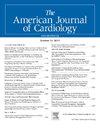氧脂素与右心室-肺动脉耦合不良和保留射血分数的心力衰竭的不良结局有关。
IF 2.3
3区 医学
Q2 CARDIAC & CARDIOVASCULAR SYSTEMS
引用次数: 0
摘要
右心室(RV)耦合肺动脉(PA)压力是保射血分数(HFpEF)心力衰竭的关键参数。氧脂素是一类调节炎症的脂肪酸信号分子,可能与RV-PA解偶联有关。我们试图确定RV-PA解耦与HFpEF临床结果的关系,并发现与RV-PA解耦相关的氧脂素。建立了一项前瞻性HFpEF队列研究。行超声心动图和右心导管检查,采集静脉血和动脉血。测量了所有参与者体内的234种氧化脂素。Kaplan Meier曲线用于评估三尖瓣环形平面收缩偏离(TAPSE)与右心室收缩压(RVSP)比与死亡率或心力衰竭住院率之间的关系。火山图用于确定氧脂素与RV-PA解耦的关系。主要终点是全因死亡率和心衰住院率的综合。在我们的队列研究中,83例患者(平均年龄68.69±10.7岁,67.5%为女性)具有TAPSE/RVSP数据并进入分析。受试者工作特征(ROC)分析确定TAPSE/RVSP的最佳切点为0.31。TAPSE / RVSP本文章由计算机程序翻译,如有差异,请以英文原文为准。
Oxylipins are Associated With Poor Right Ventricular to Pulmonary Artery Coupling and Adverse Outcomes in Heart Failure With Preserved Ejection Fraction
Right ventricular (RV) coupling to pulmonary artery (PA) pressure is a key parameter in heart failure with preserved ejection fraction (HFpEF). Oxylipins, a class of fatty acid signaling molecules that regulate inflammation, may be associated with RV-PA uncoupling. We sought to determine the association of RV-PA uncoupling with clinical outcomes in HFpEF and to discover oxylipins associated with RV-PA uncoupling. A prospective HFpEF cohort study was established. Echocardiogram and right heart catheterization were performed and venous and arterial blood samples were collected. 234 oxylipins were measured in all participants. Kaplan Meier curves were used to assess the relationship between the tricuspid annular plane systolic excursion (TAPSE) to RV systolic pressure (RVSP) ratio and mortality or heart failure (HF) hospitalizations. Volcano plots were used to determine the relationship between oxylipins and RV-PA uncoupling. The primary endpoint was a composite of all-cause mortality and HF hospitalizations. 83 patients (mean age 68.69 ± 10.7 years, 67.5% female) in our cohort study had TAPSE/RVSP data and entered the analysis. Receiver operating characteristic (ROC) analysis determined an optimal cutpoint of TAPSE/RVSP of 0.31. TAPSE/RVSP <0.31 was associated with higher risk of the primary endpoint (HR = 2.61, 95% CI = 1.28 to 5.33, p = 0.008). Arterial oxylipins 19(R)-OH PGF2a and 20-OH PGF2a, and venous oxylipin 7(8)-EpDPE were associated with an increased odds of TAPSE/RVSP <0.31, while arterial oxylipin 20-HETE was associated with decreased odds of TAPSE/RVSP <0.31. In conclusion, RV-PA uncoupling is associated with higher risk of all-cause mortality or HF hospitalizations in patients with HFpEF. Specific oxylipins were associated with RV-PA uncoupling.
求助全文
通过发布文献求助,成功后即可免费获取论文全文。
去求助
来源期刊

American Journal of Cardiology
医学-心血管系统
CiteScore
4.00
自引率
3.60%
发文量
698
审稿时长
33 days
期刊介绍:
Published 24 times a year, The American Journal of Cardiology® is an independent journal designed for cardiovascular disease specialists and internists with a subspecialty in cardiology throughout the world. AJC is an independent, scientific, peer-reviewed journal of original articles that focus on the practical, clinical approach to the diagnosis and treatment of cardiovascular disease. AJC has one of the fastest acceptance to publication times in Cardiology. Features report on systemic hypertension, methodology, drugs, pacing, arrhythmia, preventive cardiology, congestive heart failure, valvular heart disease, congenital heart disease, and cardiomyopathy. Also included are editorials, readers'' comments, and symposia.
 求助内容:
求助内容: 应助结果提醒方式:
应助结果提醒方式:


